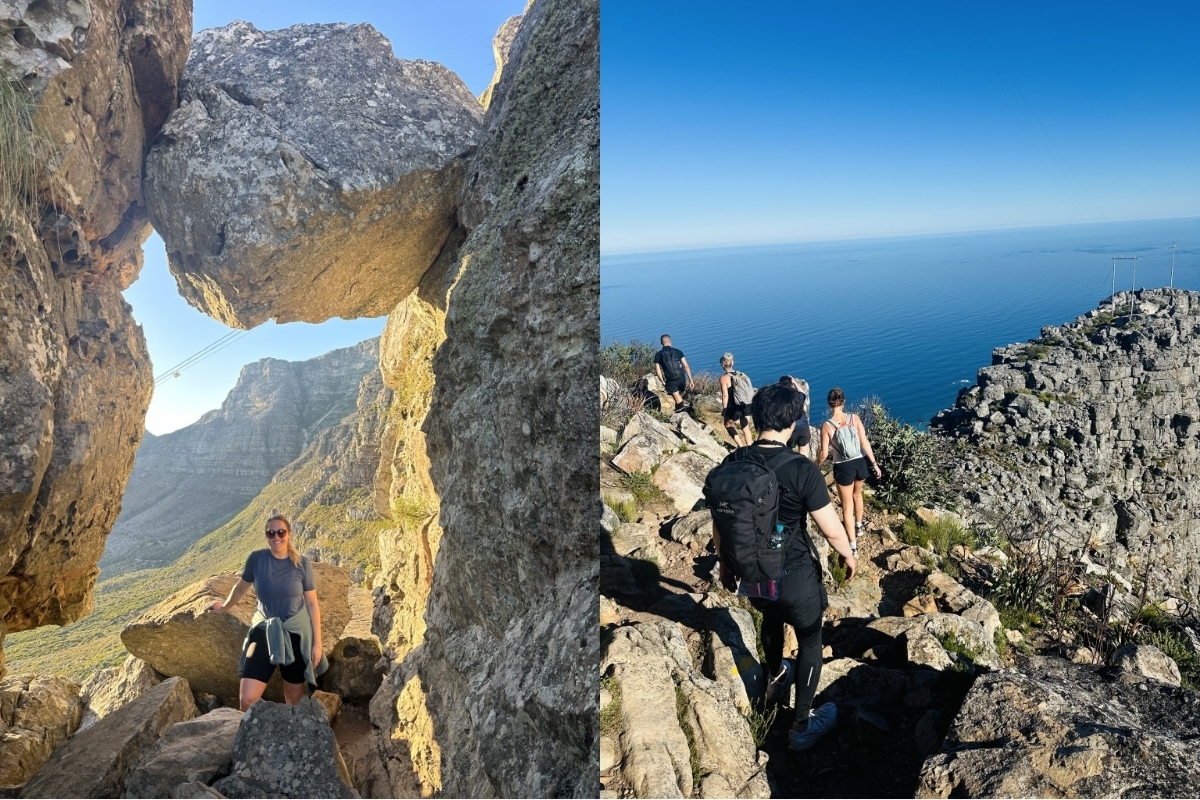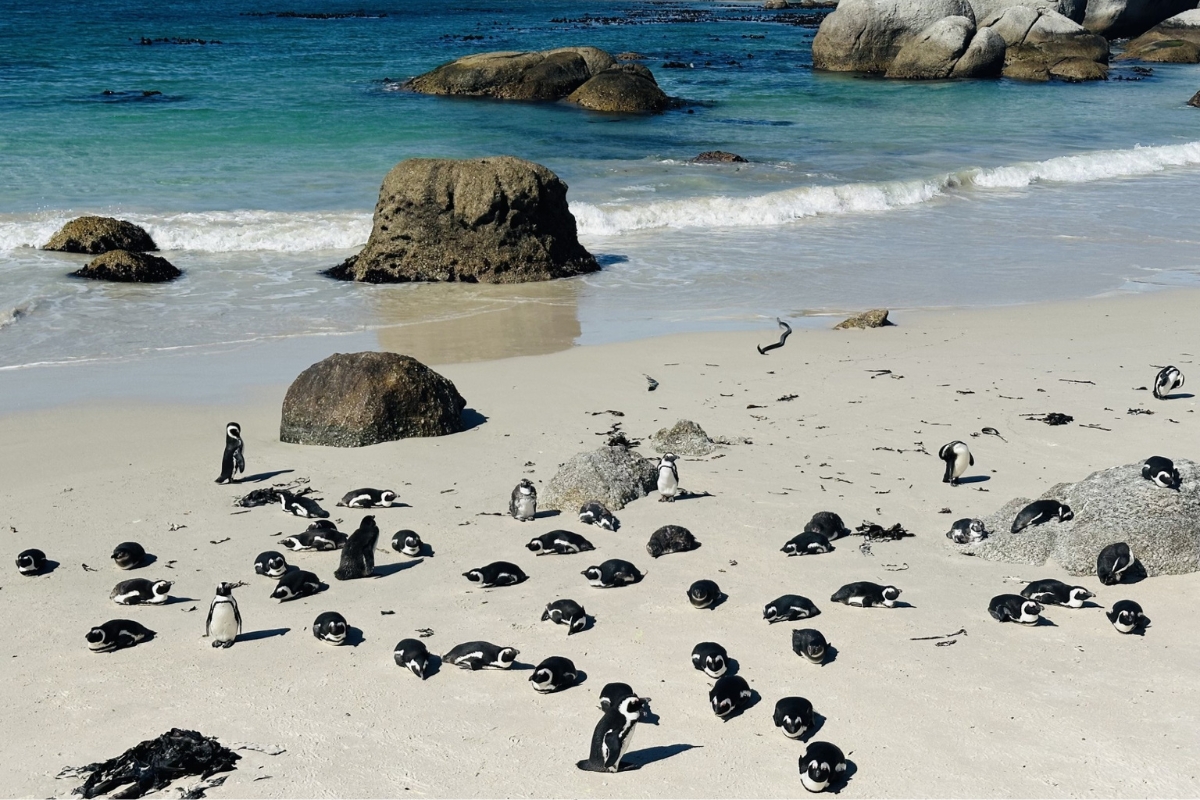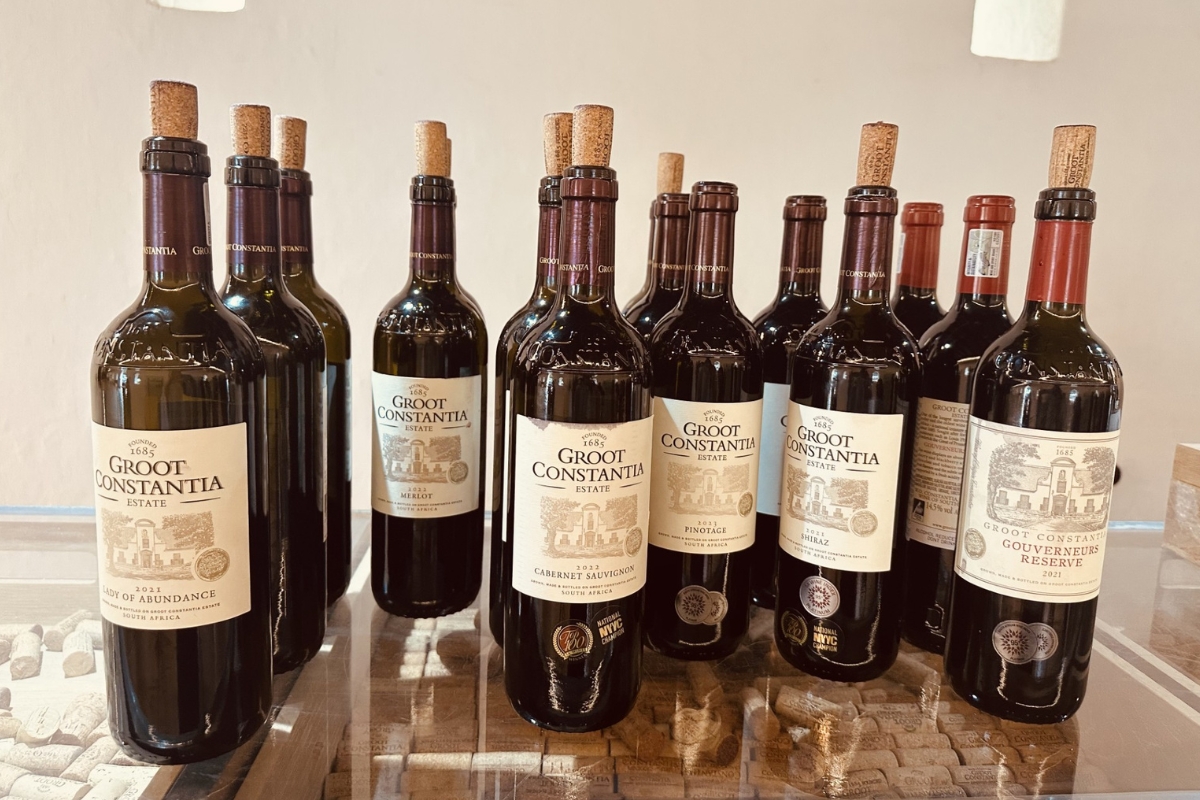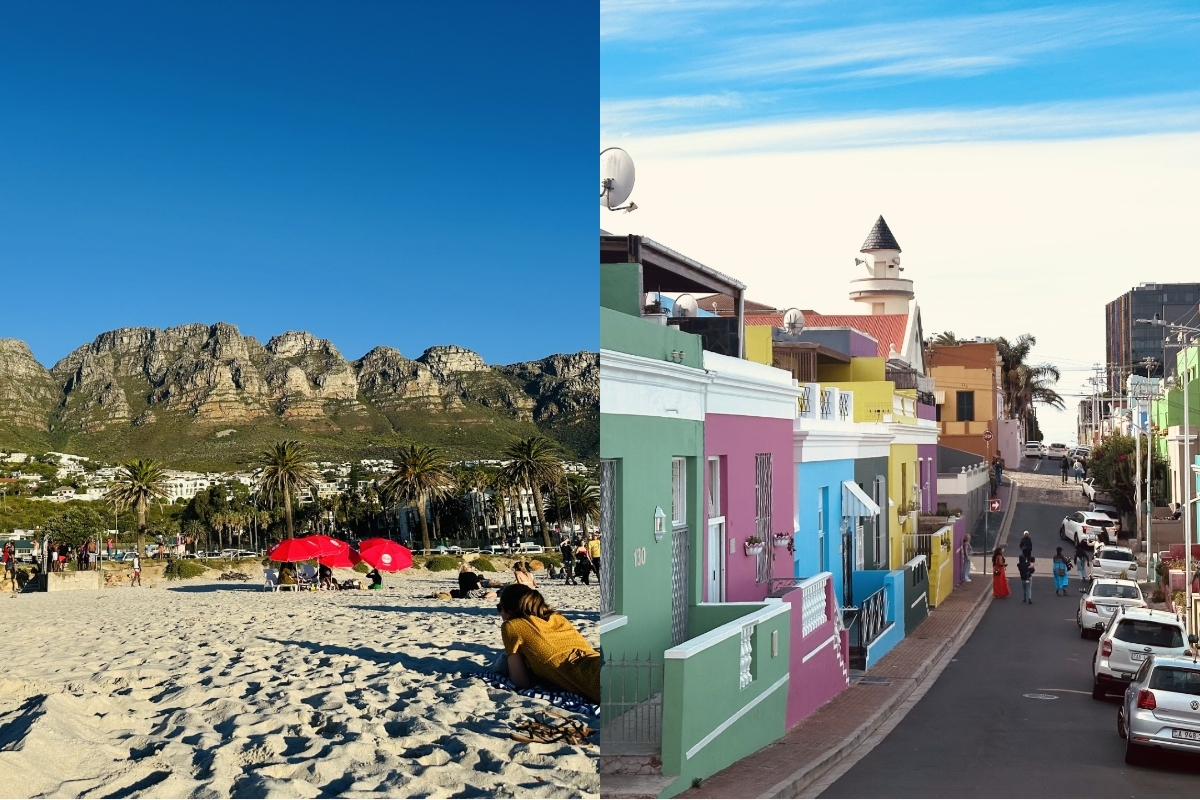


Explore Cape Town with Destination Expert Megan! From hiking the iconic Table Mountain and spotting penguins at Boulders Beach to sipping wine in the historic Constantia Valley and soaking in the vibrant streets of Bo-Kaap, Cape Town is a city that stuns at every turn. Join Megan as she dives into the rich culture, breathtaking scenery, and unforgettable experiences that make South Africa’s Mother City a destination like no other.
Hello from Cape Town, South Africa! My name is Megan, Destination Expert at SA Expeditions. Recently I had the opportunity to spend a few days in Cape Town soaking in the city’s dynamic culture and stunning scenery. Join me as I cover the highlights of the Mother City!
Hiking Table Mountain
Section Type: standardWidthImageS
From secret rock arches to cliffside paths above the sea, Megan uncovers Cape Town’s wild side—one epic step at a time. (Photo: Megan Ribeiro)

For my first morning in the Mother City, I visited the most iconic Cape Town landmark, Table Mountain. Rather than take the cable cars straight up to the summit (which is the most popular way to explore the mountain), I opted for a slightly more adventurous alternative, by hiking up to the top!
With a 6:30am pick-up (to beat the mid-day sun), my guide collected me from my hotel in the seaside neighborhood of Sea Point, as we drove a short 15 minutes to the trail head of our hike. The trail on today’s agenda is the India Venster, a challenging route that features rock scrambling and sections with chains and ladders – it requires proper footwear as well as an experienced guide (not recommended for those with a fear of heights).
The first 20 minutes was the hardest, as you pass through a section of steep steps as you make your way up the mountain. While you’ll definitely feel it in your legs, the views from the top make it all worth it. From this vantage point you’ll get postcard views of the city bowl down below as well as Robben Island – the famous maximum-security prison where Nelson Mandela was held captive for 18 years.
Next, you’ll continue where the trail becomes more technical with scrambles, rocky ledges with chains and staples to assist on the vertical sections (I found this section to be very doable with the assistance of a professional guide coaching you through your hand and foot placement the entire way). As you ascend, the trail gradually wraps around the western edge, providing you with breath taking views of the Atlantic Ocean and Twelve Apostles Mountain range.
Finally, after 3 hours of hiking we arrived at the Table Mountain Summit Plateau near the upper cable car station (complete with paved walkways, restrooms, a café and souvenir shop making Table Mountain accessible to all). After taking in the 360-degree view, we descended the mountain via cable car (to which my tired legs were very grateful).
Exploring the Cape Peninsula: Wildlife + Wild rugged Beauty
Section Type: standardWidthImageS
African penguins lounging at Boulders Beach—Cape Town’s cutest coastal residents. (Photo: Megan Ribeiro)

The next morning, after a lovely breakfast, I ventured out of the city on a full day tour of the Cape Peninsula. This region, known for its rugged wind-swept natural beauty, did not disappoint. Within the first 15 minutes of the drive, I was already in awe as we drove through the scenic oceanfront neighborhoods of Sea Point Clifton and Camps Bay. Our first stop was the picturesque coastal fishing village of Hout Bay, just 12 miles south of Cape Town. After a few photos, coffee refill and bathroom break, we were on the road again.
Next up is the iconic Chapman’s Peak Drive, one of the most scenic drives in the world as the road hugs sheer cliffs above the Atlantic with rugged mountains, blue ocean and sandy beaches as far as the eye can see. Make sure your camera is charged as there will be stops at various viewpoints along the way.
After completing the 20-minute drive through Chapman’s peak, we head further south to the historically significant Cape Point Nature Preserve, home to the Cape of Good Hope which served as a crucial landmark for sailors along the sea route between Europe and Asia in the 15th century. As soon as we drove into the park, we were confronted by wildlife, from a family of baboons on the side of the road to ostriches strolling along the wind-swept coastline. And of course, no trip to Cape Point would be complete without the obligatory photo in front of “the most south-western point of the African continent” sign.
Next, we made our way up to the old Cape Point lighthouse which has served as a warning light to ships passing near the dangerous coastline. The lighthouse is accessible by a short funicular ride up to the top or by walking up the steep but scenic pathways. At the top, you’ll take in spectacular views of rugged coastline leading up to the point where the Atlantic and Indian oceans meet.
Countless photos later, we hoped back into the car and made our way to what is the highlight of the Cape for most, Boulder’s Beach. Home to a colony of African penguins, Boulder’s Beach is one of the few places in the world where you can see penguins in their natural habitat.
This area of the beach is sectioned off, where you must pay a small entrance fee to enter as well as adhere to the walkways that allow you to get close to the penguins without disturbing them. It truly is such a surreal scene to observe these adorable creatures against the backdrop of giant smooth granite boulders (hence the name), turquoise waters and sandy white beaches.
Once our time with the penguins was finished, we made our way over to the nearby Simon’s Town, a charming and historical naval village, where we enjoyed a lunch of fresh fish at a seaside restaurant. After lunch, we started making our way back to Cape Town driving through the quaint coastal town of False Bay on the Eastern side of the peninsula. Some highlights included witnessing the shark spotters in action (a beach safety program where spotters are strategically placed at various vantage points, like lifeguards, to warn swimmers should sharks be spotted in the area) as well as driving passed the town where the hit Netflix documentary “My Octopus Teacher” was filmed.
My Cape Peninsula Tour wrapped up after one final stop – the Kirstenbosch National Botanical Gardens. With Table Mountain looming in the background, Kirstenbosch is not only famous for its stunning grounds and unique trails, but also for the fact that it is one of the very few botanical gardens in the world that cultivates only indigenous plants – making it a UNESCO World Heritage Site due to its incredible plant diversity and conservation efforts. This was the perfect end to a perfect day being completely immersed in natural beauty.
Constantia Wine Region – Sipping History
Section Type: standardWidthImageS
A taste of history at Groot Constantia—South Africa’s oldest wine estate, dating back to 1685. (Photo: Megan Ribeiro)

Today I headed to the southern suburbs of Cape Town and visited the Constantia wine region. While often overshadowed by the famous Stellenbosch wine region, Constantia can hold her own with her historical significance (South Africa’s oldest wine-producing region, est. 1685) and stunning setting at the foot of Table Mountain. Not to mention, just a short 20-minute drive from the city center, Constantia is perfect for those who are short on time but still want an authentic wine experience in South Africa.
Out of the several vineyards to choose from in the region, I visited Groot Constantia – the oldest wine estate in South Africa. Today, Groot is not only a working wine farm but also a national monument allowing it visitors to indulge in history, gorgeous cape Dutch architecture and of course, award-winning wine in a relaxed yet refined atmosphere.
After an informative tasting of amazing wines (including a taste of Vin de Constance – a legendary sweet dessert wine that was a favorite of Napolean Bonaparte), I enjoyed lunch at one the estate’s onsite restaurants, Simon’s restaurant. The meal was excellent and perfectly paired with a wine at the suggestion of the server. Afterwards, I strolled the grounds drinking in the history and unbeatable views.
Exploring the neighborhoods of the Mother City
Section Type: standardWidthImageS
From beachside bliss to colorful culture—Cape Town’s neighborhoods are as diverse as they are unforgettable. (Photo: Megan Ribeiro)

For my final day in the Mother City, I decided to explore some of Cape Town’s most notable neighborhoods by foot. I started my morning by heading over to the Central Business district where I began my explorations at City Hall – the iconic building where Nelson Mandela gave us hist first public speech in 27 years, after being released from prison. Today, a bronze statue of Mandela now stands on the balcony overlooking the Grand Parade, the large public square in front of the hall where he addressed a crowd of over 50,000 people on February 11, 1990. After soaking in the moment, I made my way over to Greenmarket Square, a popular open-air market that sells African arts and crafts (about a 5-minute walk). More than just a place to purchase souvenirs, Greenmarket square has a long and complex history as it first began as a site for slave trading in the colonial era to becoming a beacon of hope in the 1980s as it transformed into a key site for anti-apartheid protests. Greenmarket square is a must-see site, regardless of whether you’re a shopaholic or not.
Several bags of African fabrics, jewelry, and carvings later, I had worked up an appetite, so I headed over to Bo-Kaap for authentic Cape Malay food (just a short 15-minute walk). Famous for its brightly colored houses and cobblestone streets, the neighborhood of Bo-Kapp (formerly known as the Maylay Quarter) is a historic neighborhood known for its rich Cape Malay culture in which its roots trace back to enslaved people, political exiles and skilled artisans brought over by the Dutch colonizers from Malaysia, Indonesia and India. Many of those people were Muslim which resulted in a vibrant Islamic community which can still be found in Bo-Kapp today.
After a lunch of samosas and exquisite curry, I headed over to Camps Bay for my final stop of the day. Camps Bay is one of the city’s most iconic and upscale beachfront suburbs known for its wide sandy beaches, blue ocean, and palm-lined promenade against the dramatic backdrop of the twelve Apostles Mountain range. Here I relaxed on the beach as the sun dipped below the Atlantic Ocean, all while the African drums of a street performer could be heard in the background.
Thanks for joining me on this unforgettable adventure through Cape Town! From exploring the wild beauty of the Cape Peninsula to discovering the historic Constantia wine region, I hope this journey has inspired you to experience the magic of South Africa for yourself.
Section Type: cta
If Cape Town is calling your name, view our South Africa Tours or reach out—we’d love to help you craft a personalized expedition filled with culture, scenery, and once-in-a-lifetime memories!


Company
Partners
Copyright © 2025 SA Luxury Expeditions LLC, All rights reserved | 95 Third Street, 2nd floor, San Francisco, CA, 94103 | 415-549-8049
California Registered Seller of Travel - CST 2115890-50. Registration as a seller of travel does not constitute approval by the state of California.










